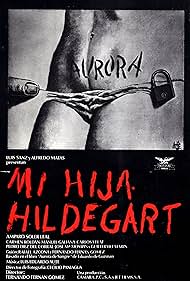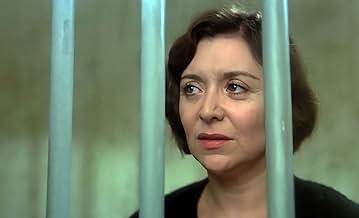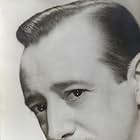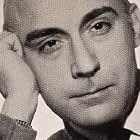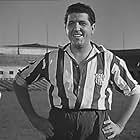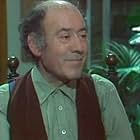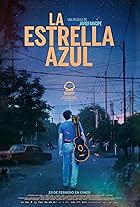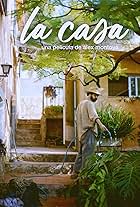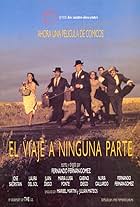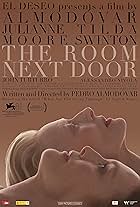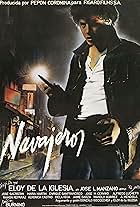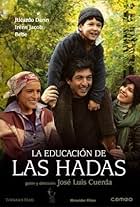Aurora Rodriguez confesses to murdering her daughter Hildegart to mold her into a feminist philosopher, set during Spain's Second Republic. Her efforts to stop Hildegart's marriage led to th... Read allAurora Rodriguez confesses to murdering her daughter Hildegart to mold her into a feminist philosopher, set during Spain's Second Republic. Her efforts to stop Hildegart's marriage led to the brutal killing.Aurora Rodriguez confesses to murdering her daughter Hildegart to mold her into a feminist philosopher, set during Spain's Second Republic. Her efforts to stop Hildegart's marriage led to the brutal killing.
Photos
Carles Velat
- Lucas López
- (as Carlos Velat)
Josep Maria Angelat
- Juan Botella Asensi
- (as José María Angelat)
- Director
- Writers
- All cast & crew
- Production, box office & more at IMDbPro
Storyline
Did you know
- GoofsIn the opening credits the title of the film is misspelled: "Mi hija Hildelgart", instead of "Mi hija Hildegart".
Featured review
Based on the realist novella written by Eduardo de Guzman titled Aurora de Sangre . Regarding Hildegart who was born and raised by her mother as a model for the woman of the future. At the beginning Aurora Rodriguez (Amparo Soler Leal) goes to a police station to assume the death of her daughter Hildegart (Carmen Roldán) , that she has had schemes to convert in an intelligent philosopher , model for the feminist, but finally murder her when she plans to be married.
This is not the typical drama by that time , here there is a deep social denounce about the female repression , dominance and feminism during the Thirties and concerning the actual happenings occured during the II Spanish Republic. Dealing with a peculiar family , both mother and daughter , developing the extreme domain , ambition , rivalry , envy and egoism of their two misfit members, being paced by means of flashbacks . Highly acclaimed pic offering , though really unknown , with an atmospheric and evocative cinematography by by the notorious cameraman Cecilio Paniagua . Brooding and harrowing picture is well set in the convulsive years previously Spanish Civil War , splendidly photographed , being stunningly and mostly shot on scenaries , in Madrid . As well as an engaging and thoughtful script from prestigious writer Rafael Azcona , along with Fernando Fernan Gómez himself .
It packs and atmospheric and evocative score by the famous singer and composer Luis Eduardo Aute . The motion picture was well directed by Fernando Fernán Gómez and it failed at the Spanish boxoffice . Fernán Gómez appeared in more than 200 films , directed another 20 and wrote novels , plays and poetry . He was a member of the Spanish Royal Academy and one of the best actors of the film history . Along with Icíar Bollaín , he's the only person to have been nominated as performer (El Abuelo (1998), director (El Viaje a Ninguna Parte (1986) and writer (Lázaro De Tormes (2001) for three different movies at the Goya awards . He actually won in every category at least once . This prolific and prestigious actor also directed a few films , such as : ¨Lazaro De Tormes¨ , ¨Fuera De Juego ¨, ¨Mambrú Se Fue a La Guerra¨ , ¨5 Tenedores¨ , ¨5.000 Dias Juntos¨ , ¨Ninette¨ , ¨Venganza De Don Mendo¨ , ¨El Extraño Viaje¨ that is today deemed a real ¨Cult Movie¨ and his greatest success ¨Viaje a Ninguna Parte¨ .
Based on real deeds , these are the following ones : Hildegart Rodríguez Carballeira ( 1914-1933 in Madrid) was an activist for socialism and the sexual revolution, She spoke 6 languages at the age of eight, she finished law school as a teenager and was the leader of the Spanish Socialist Workers Party which she abandoned in favor of extreme republicanism. When she was 18 years old and had become internationally known, her mother shot her dead. Hildegart was conceived in Ferrol by Aurora Rodríguez Carballeira and an undisclosed biological father chosen by her mother with eugenic intentions. When she was sure that she was pregnant, she moved to Madrid, where she was born Hildegart. Aurora set a clock to wake up every hour, allowing her to change her sleeping position so that blood could flow to the fetus evenly. Her birth certificate and her baptism certificate reads: Hildegart Leocadia Georgina Hermenegilda María del Pilar Rodríguez Carballeira, but she only used her first name. Despite Aurora's atheism and her opposition to her birth registration, she baptized (late) the girl on March 23 and was registered on April 29. Her mother used to explain that Hildegart meant "Garden of Wisdom" in German, but there is no basis for that, the name was an invention or alternative spelling of the Norse / German name Hildegard. According to a subsequent investigation by Rosa Cal, her father was a brilliant military chaplain, Alberto Pallás. In June 1928, at age 13 and a half, Hildegart enrolled in the Faculty of Law of the Complutense University of Madrid. She subsequently taught at her School of Philosophy during the Second Spanish Republic. Hildegart was one of the most active people in the Spanish movement for sexual reform. She was related to the European avant-garde, corresponding with Havelock Ellis, whom she translated, and Margaret Sanger. At the founding of the Spanish League for Sexual Reform, chaired by Dr. Gregorio Marañón, she was elected unopposed secretary. She corresponded with many other European personalities, accompanying Herbert George Wells on his visit to Madrid, but rejecting his offer to go to London as his secretary. This offer from Wells, who wanted it to be fully developed thanks to the influence of her mother, fostered Aurora's ideas of persecution. There were several hypotheses about the cause of the murder. Hildegart may have fallen in love. She intended to separate from her mother who, out of paranoia, threatened to commit suicide. Aurora's explanation was that "the sculptor, after discovering a minimal imperfection in her work, destroys it." He shot his daughter twice in the head and twice in the heart . Aurora herself was sentenced to 26 years, but later she was transferred to a psychiatric institution in Ciempozuelos, Madrid, where she died in 1955.
This is not the typical drama by that time , here there is a deep social denounce about the female repression , dominance and feminism during the Thirties and concerning the actual happenings occured during the II Spanish Republic. Dealing with a peculiar family , both mother and daughter , developing the extreme domain , ambition , rivalry , envy and egoism of their two misfit members, being paced by means of flashbacks . Highly acclaimed pic offering , though really unknown , with an atmospheric and evocative cinematography by by the notorious cameraman Cecilio Paniagua . Brooding and harrowing picture is well set in the convulsive years previously Spanish Civil War , splendidly photographed , being stunningly and mostly shot on scenaries , in Madrid . As well as an engaging and thoughtful script from prestigious writer Rafael Azcona , along with Fernando Fernan Gómez himself .
It packs and atmospheric and evocative score by the famous singer and composer Luis Eduardo Aute . The motion picture was well directed by Fernando Fernán Gómez and it failed at the Spanish boxoffice . Fernán Gómez appeared in more than 200 films , directed another 20 and wrote novels , plays and poetry . He was a member of the Spanish Royal Academy and one of the best actors of the film history . Along with Icíar Bollaín , he's the only person to have been nominated as performer (El Abuelo (1998), director (El Viaje a Ninguna Parte (1986) and writer (Lázaro De Tormes (2001) for three different movies at the Goya awards . He actually won in every category at least once . This prolific and prestigious actor also directed a few films , such as : ¨Lazaro De Tormes¨ , ¨Fuera De Juego ¨, ¨Mambrú Se Fue a La Guerra¨ , ¨5 Tenedores¨ , ¨5.000 Dias Juntos¨ , ¨Ninette¨ , ¨Venganza De Don Mendo¨ , ¨El Extraño Viaje¨ that is today deemed a real ¨Cult Movie¨ and his greatest success ¨Viaje a Ninguna Parte¨ .
Based on real deeds , these are the following ones : Hildegart Rodríguez Carballeira ( 1914-1933 in Madrid) was an activist for socialism and the sexual revolution, She spoke 6 languages at the age of eight, she finished law school as a teenager and was the leader of the Spanish Socialist Workers Party which she abandoned in favor of extreme republicanism. When she was 18 years old and had become internationally known, her mother shot her dead. Hildegart was conceived in Ferrol by Aurora Rodríguez Carballeira and an undisclosed biological father chosen by her mother with eugenic intentions. When she was sure that she was pregnant, she moved to Madrid, where she was born Hildegart. Aurora set a clock to wake up every hour, allowing her to change her sleeping position so that blood could flow to the fetus evenly. Her birth certificate and her baptism certificate reads: Hildegart Leocadia Georgina Hermenegilda María del Pilar Rodríguez Carballeira, but she only used her first name. Despite Aurora's atheism and her opposition to her birth registration, she baptized (late) the girl on March 23 and was registered on April 29. Her mother used to explain that Hildegart meant "Garden of Wisdom" in German, but there is no basis for that, the name was an invention or alternative spelling of the Norse / German name Hildegard. According to a subsequent investigation by Rosa Cal, her father was a brilliant military chaplain, Alberto Pallás. In June 1928, at age 13 and a half, Hildegart enrolled in the Faculty of Law of the Complutense University of Madrid. She subsequently taught at her School of Philosophy during the Second Spanish Republic. Hildegart was one of the most active people in the Spanish movement for sexual reform. She was related to the European avant-garde, corresponding with Havelock Ellis, whom she translated, and Margaret Sanger. At the founding of the Spanish League for Sexual Reform, chaired by Dr. Gregorio Marañón, she was elected unopposed secretary. She corresponded with many other European personalities, accompanying Herbert George Wells on his visit to Madrid, but rejecting his offer to go to London as his secretary. This offer from Wells, who wanted it to be fully developed thanks to the influence of her mother, fostered Aurora's ideas of persecution. There were several hypotheses about the cause of the murder. Hildegart may have fallen in love. She intended to separate from her mother who, out of paranoia, threatened to commit suicide. Aurora's explanation was that "the sculptor, after discovering a minimal imperfection in her work, destroys it." He shot his daughter twice in the head and twice in the heart . Aurora herself was sentenced to 26 years, but later she was transferred to a psychiatric institution in Ciempozuelos, Madrid, where she died in 1955.
Details
- Runtime1 hour 49 minutes
- Sound mix
- Aspect ratio
- 1.66 : 1
Contribute to this page
Suggest an edit or add missing content

